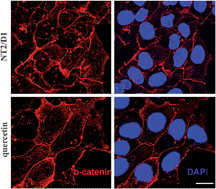Quercetin reduces pluripotency, migration and adhesion of human teratocarcinoma cell line NT2/D1 by inhibiting Wnt/β-catenin signaling
Abstract
Quercetin, a bioflavonoid found in plant foods, has a wide range of therapeutic effects. In order to examine the therapeutic potential of quercetin in teratocarcinoma, we used the human teratocarcinoma cell line NT2/D1 as an in vitro model. We have shown that quercetin inhibits the proliferation, adhesion and migration of NT2/D1 cells and downregulates the expression of pluripotency factors SOX2, Oct4 and Nanog. Our results further suggest that the anticancer effect of quercetin against human teratocarcinoma cells is mediated by targeting the canonical Wnt signaling pathway. Quercetin antagonized the Wnt/β-catenin signaling pathway in NT2/D1 cells by inhibiting β-catenin nuclear translocation and the consequent downregulation of β-catenin-dependent transcription. These data suggest that quercetin as a potent inhibitor of Wnt signaling may be an effective therapeutic agent in cancers with aberrant activation of the Wnt pathway.


 Please wait while we load your content...
Please wait while we load your content...